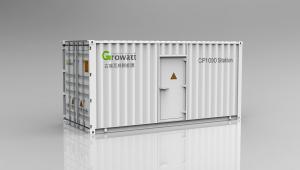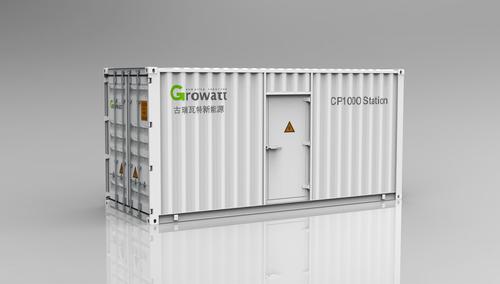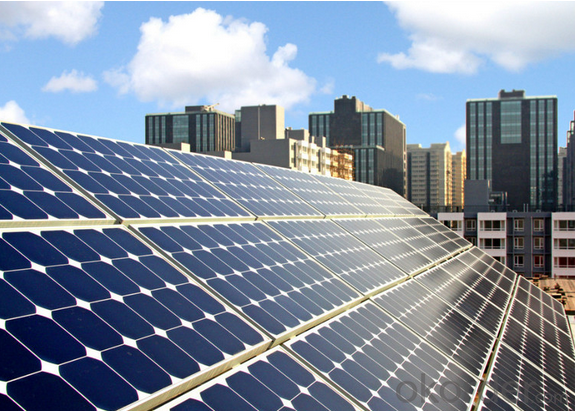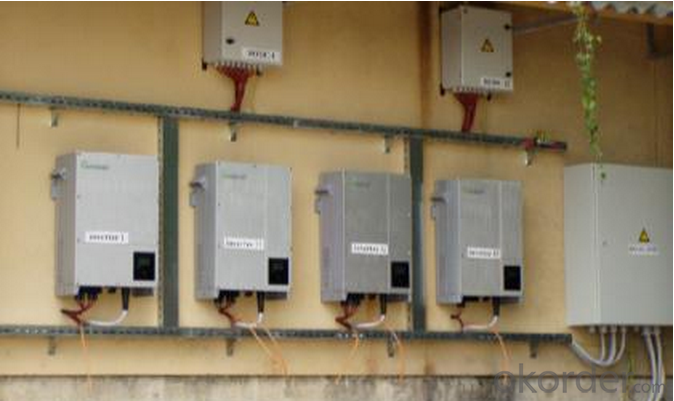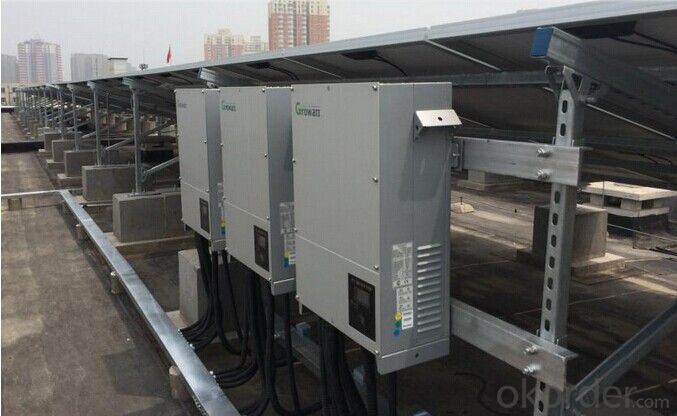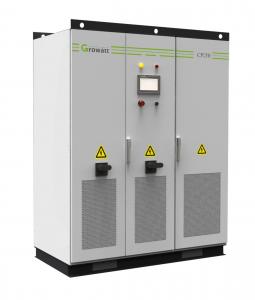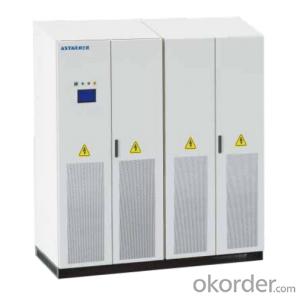Centralized Solar Inverter CP1000 Station,1260KW with TUV,EPEA,MEA,CE,CGC,LVRT,ZVRT 1.26MW
- Loading Port:
- Shekou
- Payment Terms:
- TT or LC
- Min Order Qty:
- 20 pc
- Supply Capability:
- 1000 pc/month
OKorder Service Pledge
OKorder Financial Service
You Might Also Like
1000kW integrated central inverter solution with DC distributed box and ac distributed box.
High conversion efficiency of 98.7% deliver more energy
Powerful grid management functions (including LVRT)
Active power continuous adjustment (0-100%)
Reactive power continuous adjustment (0-100%)
Integrated with SCADA monitoring system, totally compatible with smart-grid interface
Intelligent control, entirely meet the requirements of grid
Provide a turnkey solution, easy installation and maintenance
Comprehensive protection for overvoltage, islanding, short-circuit, overload, etc.
| CP1000 Station | CP1260 Station | |||
| Input data | ||||
| Max. DC power | 1150kW | 1450kW | ||
| Max. DC voltage | 1000V | 1000V | ||
| PV voltage range | 500V-1000V | 500V-1000V | ||
| MPP voltage range/nominal voltage | 500V-850V | 500V-850V | ||
| Rated Input voltage | 600V | 600V | ||
| Start voltage/power | 520V/10000W | 520V/12600W | ||
| Maximum Input current | 2240A | 2900A | ||
| Number of MPP trackers/strings per MPP tracker | 1 | 1 | ||
| Max. input current/per string | 2*10 | 2*10 | ||
| Output (AC) | ||||
| Rated AC output power | 1000kVA | 1000kVA | ||
| Rated AC voltage | 315V | 315V | ||
| AC voltage range | 250V-362V | 250V-362V | ||
| Rated frequency | 50Hz/60Hz | 50Hz/60Hz | ||
| Frequency Range | 45Hz-55Hz/55Hz-65Hz | 45Hz-55Hz/55Hz-65Hz | ||
| Rated Output Current | 1833A | 2310A | ||
| Maximum Output Current | 2016A | 2592A | ||
| Power factor | 0.9lagging-0.9leading | 0.9lagging-0.9leading | ||
| THDI | <3%(@Pac,r) | <3%(@Pac,r) | ||
| Efficiency | ||||
| Max. efficiency | 98.70% | 98.70% | ||
| Euro-eta | 98.50% | 98.50% | ||
| MPPT efficiency | 99.9% | 99.90% | ||
| Protection Devices | ||||
| DC disconnection device | DC circuit breaker | DC circuit breaker | ||
| AC disconnection device | AC circuit breaker | AC circuit breaker | ||
| DC overvoltage protection | Surge arrester type II | Surge arrester type II | ||
| AC overvoltage protection | Surge arrester type II | Surge arrester type II | ||
| Grid monitoring/Management | yes/yes | yes/yes | ||
| Ground monitoring | yes | yes | ||
| Over temperature protection | yes | yes | ||
| Insulation monitoring | yes | yes | ||
| General data | ||||
| Dimension (W/H/D)in mm | 3600/3000/2896 | 3600/3000/2896 | ||
| Weight | 6000KG | 6000KG | ||
| Operating Temperature Range | -25℃ ... +55℃ | -25℃ ... +55℃ | ||
| Relative Humidity | 0~95% | 0~95% | ||
| Degree of Protection | IP54 | IP54 | ||
| Noise Emission | 65dB(A)@1m | 65dB(A)@1m | ||
| Maximum Operating Altitude | 6000m(Derating over 3000m) | 6000m(Derating over 3000m) | ||
| Standby consumption | <200W | <200W | ||
| Cooling | Air forcedl | Air forcedl | ||
| Topology | Transformerless | Transformerless | ||
| Display | Touch screen LCD | Touch screen LCD | ||
| Communication Interface | RS485/Ethernet | RS485/Ethern | ||
| Certificates and ApprovalsCE, TUV, CGC, LVRT, ZVRT, PEA, G59 | ||||
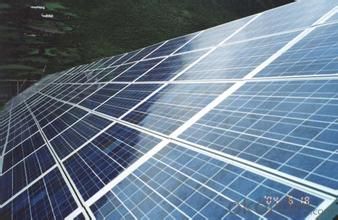
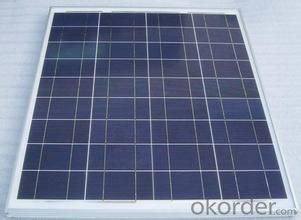
FAQ
1. Have any design tool and how to use it?
Shine Design is the system design software just for inverters, It can conduct installers to figure out panel numbers for a system, panel numbers for each string, and which inverter model is suitable for the system. Moreover, it can print a design report after input all necessary parameters, can calculate DC/AC wire wastage, annual generation, etc.
2. Does the inverter have monitoring solutions for residential system?
For small rating system, we have wired two monitoring solution (ShineNet via RS232 or RS485). (a) Local wireless monitoring solution (ShineVision via RF module communication) (b) Global wireless monitoring solution (WIFI module via WIFI network)
3. Do you have free solution for monitoring?
ShineNet is an inverter monitoring software run in Windows XP, Windows Vista, Windows 7 operating system. It can monitor inverter via RS232 (or RS232 convert to USB cable) and RS485 wire connection. Customers can purchase the cable locally to get the inverter monitored, it is simple.
- Q: How does the input frequency range affect the performance of a solar inverter?
- The input frequency range directly affects the performance of a solar inverter. A wider input frequency range allows the inverter to efficiently convert a broader range of solar panel output frequencies into usable electricity. This flexibility ensures that the inverter can effectively handle varying solar panel output and maintain stable and reliable power conversion. Conversely, a limited input frequency range may result in poor performance, reduced efficiency, and potential instability or failure of the inverter under certain conditions.
- Q: How does a solar inverter handle variations in grid frequency?
- A solar inverter handles variations in grid frequency by constantly monitoring the frequency of the grid and adjusting its own output accordingly. It does this through a process called frequency synchronization, where it synchronizes its output frequency with the grid frequency. This allows the solar inverter to seamlessly adapt to any changes in grid frequency, ensuring a stable and reliable power supply to the connected solar panels or the grid.
- Q: How do you connect solar panels to a solar inverter?
- To connect solar panels to a solar inverter, you need to follow these steps: 1. Locate the positive (+) and negative (-) terminals on the solar panels. 2. Connect the positive terminal of the first solar panel to the positive terminal of the second panel using a solar PV cable or connector. Repeat this process for other panels if necessary. 3. Connect the negative terminal of the first panel to the negative terminal of the second panel using the same method as above. 4. Once all panels are connected in series or parallel, connect the positive terminal of the last panel to the positive terminal of the solar inverter. 5. Finally, connect the negative terminal of the last panel to the negative terminal of the solar inverter. It's important to ensure that the connections are secure and tightened properly to prevent any loose connections. Following the manufacturer's instructions and consulting a professional electrician or solar installer is recommended for a safe and efficient installation.
- Q: Are there any government incentives for installing a solar inverter?
- Yes, there are government incentives for installing a solar inverter. Many countries offer financial incentives such as tax credits, grants, or rebates to encourage the adoption of renewable energy technologies like solar inverters. Additionally, some regions may have specific programs or initiatives that provide additional support or incentives for solar inverter installations. It is advisable to research and consult with local authorities or renewable energy organizations to determine the specific incentives available in your area.
- Q: What are the potential risks of short-circuiting a solar inverter?
- Short-circuiting a solar inverter can pose several potential risks. Firstly, it can cause damage to the solar inverter itself, leading to costly repairs or replacement. Secondly, it can disrupt the flow of electricity and potentially cause a fire hazard if not addressed promptly. Additionally, short-circuiting can result in power outages, causing inconvenience and potential financial losses. Lastly, it may void the warranty of the solar inverter, leaving the owner responsible for any damages or malfunctions.
- Q: What is the role of power factor correction in a solar inverter?
- The role of power factor correction in a solar inverter is to improve the efficiency and stability of the system by minimizing the reactive power and optimizing the power factor. This ensures that the inverter operates at its highest efficiency and reduces any voltage drops or disturbances in the grid. Additionally, power factor correction helps to comply with grid regulations and standards, preventing penalties and ensuring smooth integration of solar power into the electrical grid.
- Q: Can a solar inverter be used with a solar-powered desalination system?
- Yes, a solar inverter can be used with a solar-powered desalination system. A solar inverter is responsible for converting the direct current (DC) electricity produced by solar panels into alternating current (AC) electricity that can be used to power electrical devices. In the case of a solar-powered desalination system, the solar inverter would be essential to convert the DC electricity generated by the solar panels into AC electricity to power the desalination equipment and ensure the system functions properly.
- Q: Can a solar inverter be used in a hybrid solar system?
- Yes, a solar inverter can be used in a hybrid solar system. A hybrid solar system combines both solar energy and another source of energy, such as a battery or grid power. The solar inverter is responsible for converting the DC (direct current) power generated by the solar panels into AC (alternating current) power that can be used to power the electrical devices in a home or business. In a hybrid solar system, the solar inverter can still perform this function, allowing the system to utilize solar energy while also being able to draw power from other sources when needed.
- Q: Can a solar inverter work in low light conditions?
- No, a solar inverter cannot work in low light conditions as it relies on sunlight to generate electricity. Low light conditions result in reduced solar energy, which makes it difficult for the inverter to convert it into usable electricity efficiently.
- Q: How does a solar inverter synchronize with the electrical grid?
- A solar inverter synchronizes with the electrical grid by constantly monitoring the voltage and frequency of the grid. It adjusts its own output voltage and frequency to match the grid's, ensuring that the electricity generated by the solar panels is in phase and synchronized with the grid. This synchronization allows the solar power to be seamlessly integrated into the grid, enabling efficient power transfer and preventing any disruption to the supply.
Send your message to us
Centralized Solar Inverter CP1000 Station,1260KW with TUV,EPEA,MEA,CE,CGC,LVRT,ZVRT 1.26MW
- Loading Port:
- Shekou
- Payment Terms:
- TT or LC
- Min Order Qty:
- 20 pc
- Supply Capability:
- 1000 pc/month
OKorder Service Pledge
OKorder Financial Service
Similar products
Hot products
Hot Searches
Related keywords
